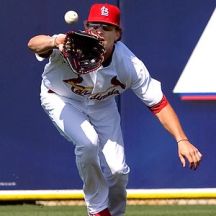Posted by cubs223425

With 33 SB's on the year, McCutchen can defiently fly around the basepaths.
Over on the forum, there has been a game called “Which Player Would You Rather Have?” It has really taken off, with over one hundred posted inquiries in just eight days. Basically, you pick two players that you find to have similar value, then ask which the replier would prefer to have. Whomever replies gives a name, often with a short reason, then presents the next pair to choose between. This thread has gotten me curious to one comparison in particular (which I’m not sure has been proposed, but I would be shocked if it wasn’t) is a pair of elite prospects, Colby Rasmus and Andrew McCutchen.
The two have a lot in common. They were born just 60 days apart in 1986. They play the same position (center field). Both were taken in the first round of the 2005 draft–McCutchen 11th, Rasmus 28th. Both have the ability to hit for average and power, while swiping some bases. They are both capable of becoming the top player at the position. As identical as they might sound, they do have some differences.
For starters, the defense has a gap. Rasmus came up and immediately posted a +9.1 UZR in center in 2009, though he regressed to a -6.5 UZR, possibly due to some nagging injuries. McCutchen, on the other hand, has been considerably worse. His -1.3 UZR in 2009 was tolerable, but 2010’a -14.4 is Adam Dunn-like ineptitude. Now McCutchen plays in a strange park with Pittsburgh, but you can only make excuses and provide hope for so long. He might improve, but he is probably just going to be Nate McLouth in center all over again (WARNING: If he gets a Gold Glove with an ugly season like McLouth, rioting will ensue). Long-term, I would expect Rasmus to stick in center no matter what, but if McCutchen continues this awful escapade, then I would expect Pittsburgh to give another player, perhaps Tabata, a chance in center.
Preventing runs is a big part of baseball, but those that produce them almost always get the spotlight in the common fan’s eyes, even in this saber movement. That is where the styles of Rasmus and McCutchen are most noticeable. Colby Rasmus is the power-speed player, while Andrew McCutchen is the speed-power guy. Rasmus will never be a high-upside base stealer, and McCutchen will never be a middle-of-the-order power threat. The question is, who would you rather have there?
McCutchen is likely to be the more consistent offensive commodity. He is likely to produce a solid .280-15-30 line every year, and he could reach up towards .300-20-40. He will mostly project in the first or second spot in the lineup, as he keeps a more steady OBP and can steal bases at a high rate. Rasmus is another story.

Colby Rasmus will save you almost as many runs as he creates.
There is more risk and reward with McCutchen’s St. Louis counterpart. While he produced a similar OBP and a higher OPS, Rasmus can be a more streaky hitter. On average, the numbers will likely sit around .275-27-15. That can have some leeway, though. His more strikeout-prone swing could see him have a season where his numbers drop to about .260-23-10. In those years, he will have to become a more efficient base stealer to keep his overall offensive game in the mix when the All-Star ballots come around. At the same time, his power and ability to get on base could give his team a line around .285-35-20. Those number won’t set the world on fire, but for a center fielder, those are great, especially if he goes back to those 2009 UZR levels.
Now I’m not some psychic, nor do I like to predict statistics in baseball, because one little adjustment can lead to something where McCutchen has a great or awful year, or Rasmus could become more patient or shorten his swing and become more consistent. He could even have some crazy .300-40-30 year, but I would not bet money on it.
As an overall offensive threat, give me McCutchen. This might have something to do with my being a Cubs fan, but that top-of-the-order speedster is something I crave. Having to watch the likes of Kosuke Fukudome and Ryan Theriot lead off makes me green with envy when I see a guy hitting .300 and stealing 30+ bases.
So, who do I want? My answer is Rasmus.If I was talking about fantasy baseball, I would probably prefer McCutchen. He will guaranteed help you get some Hrs and SBs without risking your team’s batting average (in category leagues) or lose you points for striking out (in points leagues that penalize such things).
However, I am talking about real-life baseball, where millions of dollars and World Championships are on the line. When it comes down to decision time, I want Rasmus because of his defense. Either player could be at the top of his position on offense, but that is why I want the Cards’ guy–he can do it on defense, too. McCutchen will set your team up to score. Rasmus will knock guys in and stop guys like McCutchen from getting triples by not making as many mistakes in the field. As a complete player, the Cardinals appear to have the superior talent.
But, again, I am not a psychic. Don’t come crying to me if you lose money betting on Rasmus and lose!



